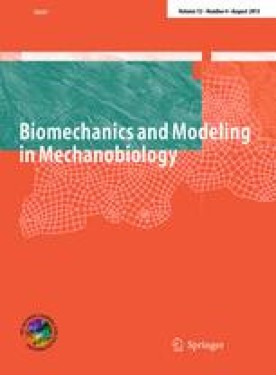- 充值
- 帮助

Mechanics regulates biological processes at the molecular, cellular, tissue, organ, and organism levels. A goal of this journal is to promote basic and applied research that integrates the expanding knowledge-bases in the allied fields of biomechanics and mechanobiology. Approaches may be experimental, theoretical, or computational; they may address phenomena at the nano, micro, or macrolevels. Of particular interest are investigations that (1) quantify the mechanical environment in which cells and matrix function in health, disease, or injury, (2) identify and quantify mechanosensitive responses and their mechanisms, (3) detail inter-relations between mechanics and biological processes such as growth, remodeling, adaptation, and repair, and (4) report discoveries that advance therapeutic and diagnostic procedures. Especially encouraged are analytical and computational models based on solid mechanics, fluid mechanics, or thermomechanics, and their interactions; also encouraged are reports of new experimental methods that expand measurement capabilities and new mathematical methods that facilitate analysis. Highlights approaches that are experimental, theoretical, or computational and that address phenomena at the nano, micro, or macro levels Integrates knowledge in the allied fields of biomechanics and mechanobiology Emphasizes analytical and computational models based on solid mechanics, fluid mechanics, or thermomechanics and their interactions Encourages reports on new experimental methods that expand measurement capabilities and new mathematical methods that facilitate analysis
- 主办单位: SPRINGER HEIDELBERG
- 出版地区: Germany
- 出版周期: 双月刊
- 别名: 生物力学和机械生物学建模
- 国际标准连续出版物号: ISSN 1617-7959
- 创刊时间: 2002年
-
vol.23 (2024)
vol.23 (2024)
5.0 3.0 06 05 04 03 02 01 -
vol.23 (2023)
vol.23 (2023)
-
vol.22 (2023)
vol.22 (2023)
-
vol.22 (2022)
vol.22 (2022)
-
vol.21 (2022)
vol.21 (2022)
-
vol.21 (2021)
vol.21 (2021)
-
vol.20 (2021)
vol.20 (2021)
-
vol.112 (2020)
vol.112 (2020)
-
vol.19 (2020)
vol.19 (2020)
-
vol.18 (2019)
vol.18 (2019)
-
vol.17 (2018)
vol.17 (2018)
-
vol.16 (2017)
vol.16 (2017)
-
vol.15 (2016)
vol.15 (2016)
-
vol.14 (2015)
vol.14 (2015)
-
vol.13 (2014)
vol.13 (2014)
-
vol.12 (2013)
vol.12 (2013)
-
vol.11 (2012)
vol.11 (2012)
-
vol.10 (2011)
vol.10 (2011)
-
vol.9 (2010)
vol.9 (2010)
-
vol.8 (2009)
vol.8 (2009)
-
vol.7 (2008)
vol.7 (2008)
-
vol.6 (2007)
vol.6 (2007)
-
vol.5 (2006)
vol.5 (2006)
-
vol.4 (2005)
vol.4 (2005)
-
vol.3 (2005)
vol.3 (2005)
-
vol.3 (2004)
vol.3 (2004)
-
vol.2 (2004)
vol.2 (2004)
-
vol.2 (2003)
vol.2 (2003)
-
vol.1 (2003)
vol.1 (2003)
-
vol.1 (2002)
vol.1 (2002)
- 1
- 2
- 3

 分析评价
分析评价
